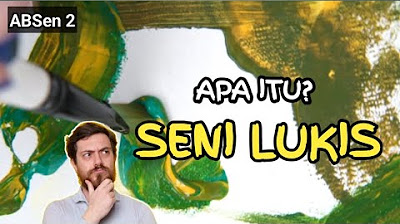Lesson 4 Painting
Summary
TLDRThis lesson introduces painting, covering its definition, media, and various styles. It explains how pigments are applied to surfaces like wood, canvas, or paper, and the role of ground layers to protect these surfaces. The lecture explores four main types of paint—oil, acrylic, watercolor, and tempera—highlighting their unique characteristics. Additionally, it discusses different painting subjects, such as portraits, still life, landscapes, and religious art. The lesson concludes by outlining popular painting styles, including abstraction, Art Nouveau, Impressionism, Cubism, Surrealism, and Pointillism.
Takeaways
- 🎨 Painting is the application of pigments to a surface (support) to create an image, design, or decoration.
- 🖌️ Common supports for painting include paper, wood, canvas, plaster, clay, and concrete.
- 🛡️ A 'ground' is applied to supports to create a non-absorbent layer between the surface and the paint.
- 🖼️ Oil paint is known for detail and contrast but takes a long time to dry and requires toxic thinners like turpentine.
- 💧 Acrylic paints are water-based, dry quickly, and are ideal for beginners, but they don’t blend as well as oils.
- 💦 Watercolor is inexpensive and dries quickly, but it’s difficult to master and hard to correct mistakes.
- 🥚 Tempera paint, often made with egg yolk, is long-lasting but requires multiple thin layers to achieve desired hues.
- 👤 Common painting subjects include portraits, real-life scenes, still life, landscapes, and religious imagery.
- ✨ Painting styles range from abstraction, art nouveau, and impressionism, to more emotional and distorted styles like expressionism.
- 🔲 Techniques like cubism (fragmented subjects) and surrealism (dream-like, symbolic visuals) offer unique artistic approaches.
Q & A
What is the definition of painting as explained in the script?
-Painting is the application of pigments to a support or surface to establish an image, design, or decoration. It refers to both the act of painting and the resulting output.
What are some of the different painting media mentioned, and how do they differ in their properties?
-The painting media mentioned include oil, acrylic, watercolor, and tempera. Oil paint takes a long time to dry and is best for detail and contrast, but requires turpentine for cleaning. Acrylics are water-based, fast-drying, and easy for beginners but harder to blend. Watercolor is affordable and dries quickly but is difficult to master. Tempera uses egg yolk or glue as a binder, dries quickly, and produces a smooth matte finish.
What is a 'support' in painting, and what is a 'ground'?
-A 'support' refers to the surface on which the paint is applied, such as paper, wood, or canvas. A 'ground' is a mixture of binder and powdered material like chalk, applied to the support to create a non-absorbent layer that protects it from damage.
How do oil paints differ from acrylic paints in terms of drying time and cleaning process?
-Oil paints take between six months to a year to dry, and they require turpentine for cleaning. Acrylic paints dry much faster and can be cleaned easily with water.
What are the disadvantages of using oil paints?
-Oil paints take a long time to dry, require toxic solvents like turpentine for cleaning, and can stain surfaces and clothing. They are also more expensive compared to other painting media.
What are the advantages and challenges of using watercolor paints?
-Watercolor paints are affordable, dry quickly, and offer good color saturation. However, they are difficult to master, and it is challenging to correct mistakes once the paint is applied.
What are the characteristics of tempera paint?
-Tempera paint uses a mixture of egg yolk or other binders, dries quickly, and produces a smooth matte finish. It is long-lasting but requires thin layers to achieve desired colors and is more time-consuming to work with.
What is abstraction in painting, and how does it simplify subjects?
-Abstraction is the reduction or simplification of subjects by omitting realistic details, focusing instead on primary shapes, colors, or forms. The imagery can be so simplified that it becomes non-objective.
What distinguishes Impressionism from Post-Impressionism?
-Impressionism is characterized by small, visible brushstrokes and bright colors, with a focus on capturing light and outdoor scenes. Post-Impressionism, on the other hand, features vivid colors, thick brush strokes, and often distorted forms, reflecting the emotional and psychological states of the artist.
What is Pointillism, and how is it applied in painting?
-Pointillism, also known as chromoluminarism, involves applying tiny dots of color to a surface. When viewed from a distance, these dots visually blend to form an image. It was developed by Georges Seurat.
Outlines

هذا القسم متوفر فقط للمشتركين. يرجى الترقية للوصول إلى هذه الميزة.
قم بالترقية الآنMindmap

هذا القسم متوفر فقط للمشتركين. يرجى الترقية للوصول إلى هذه الميزة.
قم بالترقية الآنKeywords

هذا القسم متوفر فقط للمشتركين. يرجى الترقية للوصول إلى هذه الميزة.
قم بالترقية الآنHighlights

هذا القسم متوفر فقط للمشتركين. يرجى الترقية للوصول إلى هذه الميزة.
قم بالترقية الآنTranscripts

هذا القسم متوفر فقط للمشتركين. يرجى الترقية للوصول إلى هذه الميزة.
قم بالترقية الآنتصفح المزيد من مقاطع الفيديو ذات الصلة

Materi Seni Rupa - BERKARYA SENI LUKIS - SMP Kelas 9 / Semester 1 (Kur.2013)

PENGERTIAN, ALIRAN, TEKNIK, DAN PROSEDUR SENI LUKIS || Seni Budaya Kelas 9 "Ayo Belajar SENi eps.2"

RV2 IICTS1 CHAPTER 2

Rangkuman Materi SBK Kelas 9 Bab 1: Seni Lukis

APA ITU KEPEMIMPINAN DAN TEORI KEPEMIMPINAN ??

Materi Pembelajaran kelas 10 SMK || Akuntansi Dasar || Pengertian Akuntansi, Sejarah Akuntansi
5.0 / 5 (0 votes)
